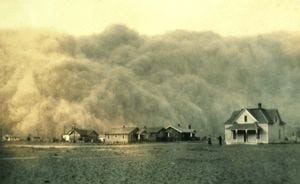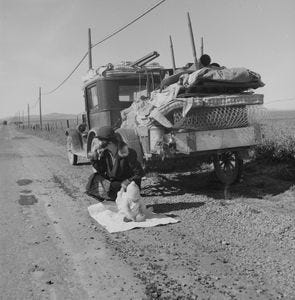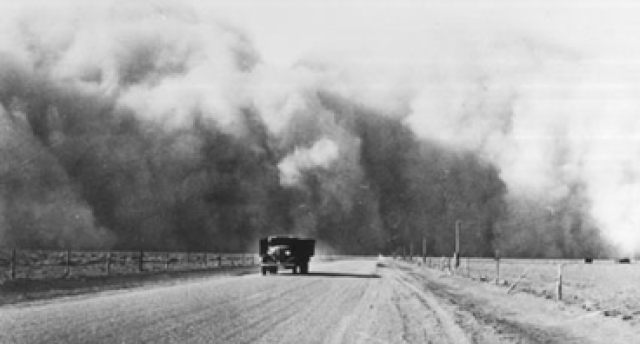Trouble in the Fields
Lessons learned from the 1930s Dust Bowl. What are the mistakes and solutions we need to remember in the 21st century?
I’m originally an “Okie.” Going through old family photos a few weeks ago, I remembered the stories my great-grandmother told us about living through the Dust Bowl days in the panhandle of Oklahoma.
The Dust Bowl was a drought period in the Great Plains that lasted from 1930 to 1936. It designates the hardest hit section of the Great Plains of the United States that extended over southeastern Colorado, southwestern Kansas, the panhandles of Texas and Oklahoma, and northeastern New Mexico.
The Dust Bowl was caused by several economic and agricultural factors, including federal land policies, changes in regional weather, farm economics, and other cultural factors. After the Civil War, a series of federal land acts coaxed pioneers westward by incentivizing farming in the Great Plains.
The Homestead Act of 1862, which provided settlers with 160 acres of public land, was followed by the Kinkaid Act of 1904 and the Enlarged Homestead Act of 1909. These acts led to a massive influx of new and inexperienced farmers across the Great Plains.
An article in permaculturenews.com states that “The dust-bowl era of the ‘dirty thirties’ was the worst man-made environmental disaster in U.S. history, and one of the worst in the world.
It was truly a disaster of Biblical proportions.”
My great-grandmother Shaw lived in the western part of the state where the drought was the most severe. Storms created enormous clouds and gusts of red dust that billowed across the skyline. The flat land allowed the wind to rage to 40mph or more. Instead of rain, they experienced a relentless shower of dust and grit. The strong winds carried dust into every crack and crevice. There was no way to keep it out. They lost friends, witnessed the loss and suffering livestock and pets, and many lost their property. They sometimes had to sit in their automobile with their faces covered while the storm violently rocked it from side to side. They had to keep their eyes closed. No one was able to speak. Some of my Shaw family stayed in the west, but my great-grandmother moved east to be with her daughter’s family.
Fortunately, my grandmother and her cousin had moved to Tulsa before the Dust Bowl occurred. Tulsa is where my grandmother met and married my grandfather. The Weaver family had settled in Tahlequah, in Eastern Oklahoma, where they didn’t experience the same severity of drought and distress during the Dust Bowl years, although the depression created hardship. The farm was situated along the Illinois river, a branch of the Arkansas river and a valuable water source.
Tahlequah is a small town in the foothills of the Ozark Mountains, established as the capital of the 19th-century Cherokee Nation in 1839. It was part of the new settlement in Indian Territory after the Cherokee Native Americans were forced west from the American Southeast on the Trail of Tears.
My great-grandmother Weaver was half-Cherokee and came from the Tahlequah area. I barely remember her. I wasn’t old enough to ask probing questions about her life or how they lived in “the olden days.” I later learned that the age-old wisdom and growing methods of her Native American family, from companion planting to regenerative practices, were passed along to my grandfather. Both my grandfather and father practiced what is now called a no-dig method of gardening.
Instead of digging below the topsoil to remove weeds, the no-dig method relies on applying compost and well-rotted manure to the surface. This method emulates the natural seasonal decomposition of plants. They added the fall leaves and garden waste to the compost. Nothing is lost. No-dig gardening helps to retain moisture and prevent erosion. It also allows plants, fungi, and soil organisms to break down and incorporate nutrients that enrich the soil. Organic soil is dark, rich, and aromatic—it smells fresh and clean. No-dig gardening doesn’t disrupt the energetics of the soil. Soil fertility grows year after year instead of becoming depleted. Once established, an organic, no-dig garden is much less work and has a higher, and more profitable crop yield.
Our multi-generational family farm had several sizeable but manageable gardens with beds of large onions, garlic, and marigolds planted around the edge to prevent erosion and keep pests out. The farm also had nut groves of large pecan and black walnut trees, along with abundant berry bushes. The livestock and chickens were free-range. My grandmother wormed them using black walnut hull tincture that she made.*
My family lived seasonally on the fruits and nuts from the orchard, garden vegetables, and eggs and meat that they raised. My grandmother and mother canned vegetables and fruits for winter use. Flour and grain meals were purchased or bartered with the local grocery store.
Decades after the Dust Bowl, our family farm was still healthy and productive. I remember helping my grandfather carry vegetables to a bushel basket he had tied to the fence next to our gate. It always contained food from the garden, available for anyone to take or exchange. He explained, “there are always people who need food, so always grow extra — it doesn’t cost you any more.” Seed saving was a logical cost-saving activity. Although I was young, my parents let me help bag the dried seeds we would use the following spring. These, along with seed potatoes for the next season and the root crops for the coming winter, were stored in a cool root cellar, where I would sometimes play during the hottest summer afternoons.
Starting a no-dig garden may require an initial investment to purchase compost and manure if you can’t locate any for free. However, there are no annual chemicals to buy, the land stays cleaner, and the nutritional density of the food is much higher due to the enhanced quality of the soil.
I remember when my grandparents celebrated their 70th wedding anniversary— they were still active and vibrant. They passed well into their 90s and had very few health problems. Early one morning, when I was visiting them, my then 92-year-old grandfather took a teaspoon of Pepto-Bismol and said he needed his morning “medicine” because he no longer tolerated the strong, black coffee he always had with breakfast. He never took any other medicine besides the food and herbs he continued to grow in his garden.
My grandparents knew hard times, but they were strong and resilient. I attribute their strength and health to their quality lifestyle and organic food. They were genuine and caring people who gave freely to family and supported their community. They were “hardy” people, like the many of their time who survived the Dust Bowl and persevered to rebuild their lives.
When I look at the current environmental and agricultural news, I hope we will remember the lessons of the Dust Bowl era. We need to ask more questions: Why continue dependence on chemicals and factory farming methods that don’t work in partnership with the land? Why do we need to vaccinate bees for the first time in over 13,000 years of successful and healthy cooperation with these and other pollinators?
Why do we so often hear about sustainability rather than regeneration? I read the definitions of both terms. Sustainability focuses on “doing less bad.” Regeneration prioritizes “doing more good over less bad.” Sustainability is a good goal, but it implies stasis, hoping not to make matters worse. Regeneration is more aggressive with the goal of returning the environment to it’s previous state. There are organic solutions that are easy and affordable to implement that are regenerative. Do more good. Everyone will benefit.
The Dust Bowl happened again in the 1950s. It didn’t escalate because many people had implemented better practices. The government had also restored prairie grasses that stopped severe soil erosion. I wonder if current corporate farming practices that disrupt the soil on a large scale will lead us back there once again. Many say it is a possibility. Others are beginning to return to organic farming, something we can all do regardless of scale.
There's a book up on the shelf about the dust bowl days.
And there's a little bit of you and a little bit of me
in the photos on every page.
Now our children live in the city and they rest upon our shoulders,
They never want the rain to fall or the weather to get colder.
Nanci Griffith, singer and songwriter
In the PBS film, The Dust Bowl, by Ken Burns, he lays out the law of diminishing returns where economic ambition meets environmental reality. “Ultimately, Nature does not punish us — rather, we punish ourselves through our ignorance and greed.”
The following is an informative and encouraging interview from 2012 between Ken Burns and Paula Zahn. They discussed the documentary release and the Dust Bowl's legacy on both the environment and the culture of the United States. [Time: 1:07:31]
Nanci Giffith: Trouble in the Fields [Time: 3:17]
*Here’s a well-researched article on the blog Free Range Wool about making black walnut tincture and worming chickens and livestock. It is effective for humans too and many herb companies sell it through health food stores if you don’t want to make your own.





